A Comprehensive Guide to the 3 Basic Roofing Types
Your roof is wearing out. The shingles are old, faded, and growing a bit of moss. Maybe a few are missing or beginning to curl.
It’s time to start thinking about replacing your roof. But what type of roofing material should you choose?
At Choice Exteriors, we’d love to help out! We install roofs and are committed to quality, customer-focused work. That’s why we’ll walk you through your primary roofing choices, helping you decide what you want to use on your own home or business.
Overview of Your Roofing Options
Throughout history, people have constructed roofs out of stone, clay, metal, and straw, using what they had on hand to make a watertight shelter for themselves.
But some products have always been superior to others.
For instance, although thatched roofs could last a good 25-40 years, that pales in comparison to the stone, copper, or lead cathedral roofs that survived for decades or even centuries with proper repair and maintenance.
Today, your roofing options are nearly limitless—from wooden shingles to clay tiles to old-fashioned slate tiles. You can even take an example from the inhabitants of the Faroe Islands and create a living roof.
But to narrow down your options, you should be aware of three basic types of roofing that are practical, cost-effective, and attractive.
They are:
- Asphalt Shingles
- Corrugated Metal Roofing
- Standing-Seam Metal Roofing
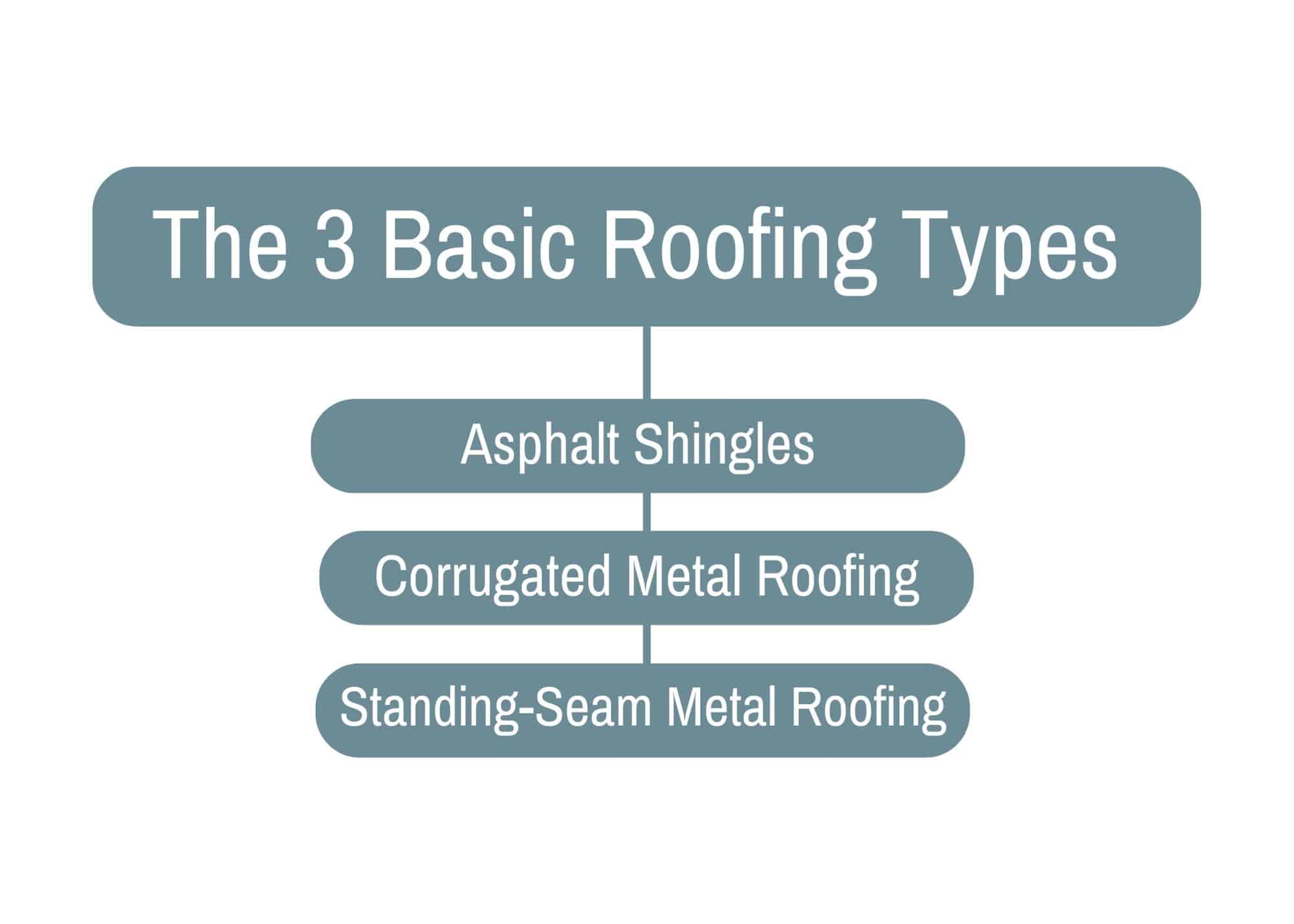
Let’s go over the pros and cons of each roofing type, as well as the time, money, and tools needed to install them.
Quick Question: Will you re-roof or completely replace your roof?
Before we get into the specifics of each roofing type, let’s talk a bit about re-roofing vs. replacing your roof.
A roof replacement involves tearing off the existing roofing materials and replacing them with new ones.
Re-roofing is a simpler process. In the right circumstances, you can install asphalt shingles, corrugated metal roofing, or standing-seam metal roofing on top of an existing shingle roof. We’ll get into the specific circumstances later, but remember, if your roof is storm-damaged, has structural damage, or is leaking severely, you should do a complete replacement to deal with the damage underneath!
Asphalt Shingles: What You Need to Know
Asphalt shingles are the most popular roofing material for homes in the USA—80% of homes use asphalt shingles!

And although asphalt shingles aren’t as ubiquitous on commercial buildings, they’re still a popular choice.
But remember, just because it’s popular doesn’t necessarily mean it’s the best option!
History of Asphalt Shingles
Shingles and roofing tiles made from wood, stone, metal, or clay have been used since ancient times. But modern asphalt shingles were invented by Henry Reynolds at the turn of the 20th century.
Reynolds took roofing felt and coated it in asphalt to make it waterproof. Later, he learned to add stone granules to make it more durable, and he cut the finished product into shingles and began installing it on roofs.
Because they were both waterproof and cost-effective, asphalt shingles rapidly gained popularity.
Pros and Cons of Asphalt Shingles
Let’s go over some of the main pros and cons of asphalt shingles.
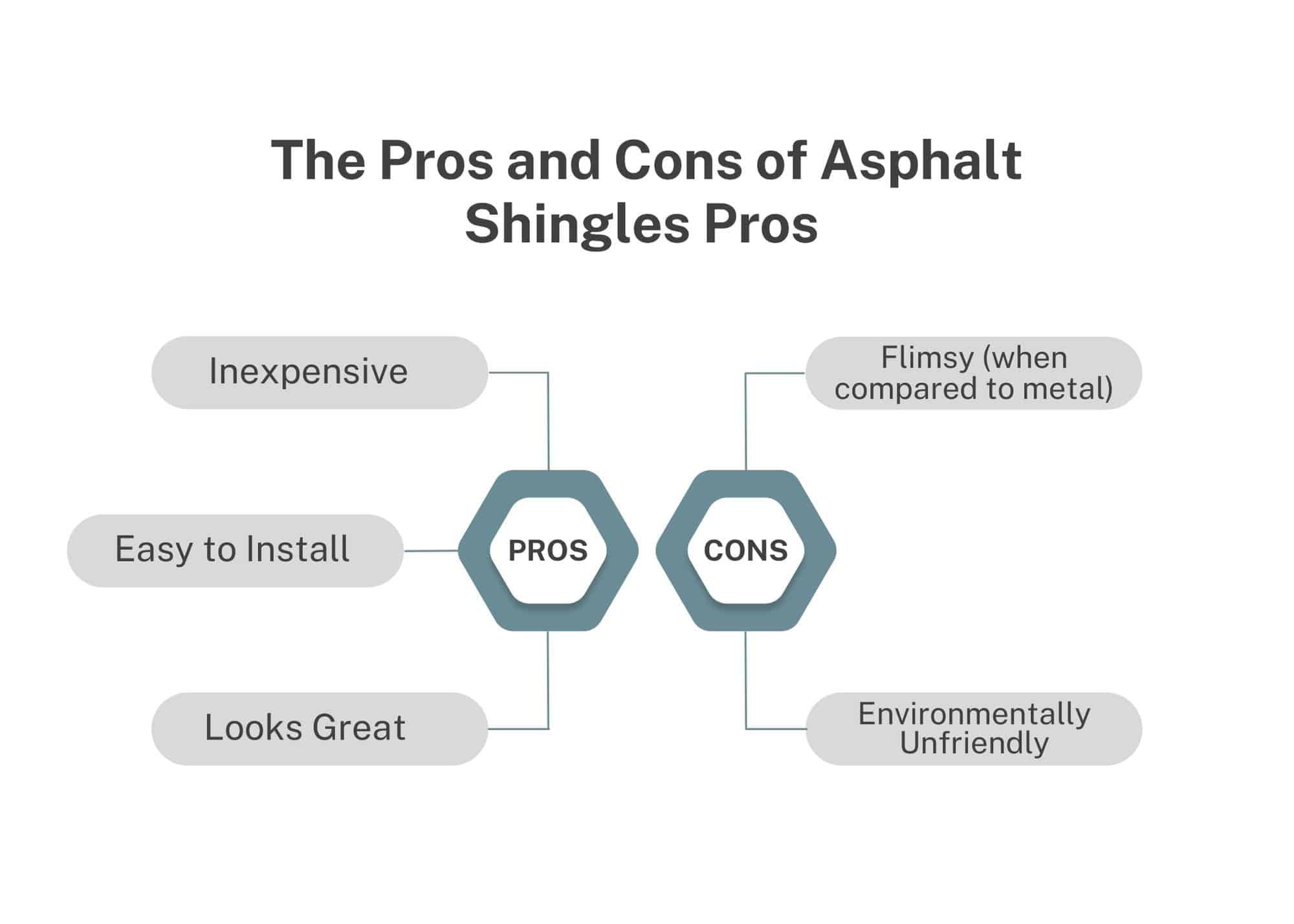
Pros
- Inexpensive: Asphalt shingles are one of the cheapest roofing options out there. Installation and materials typically cost $1 to $6 per square foot.
- Easy to install: Asphalt shingles are a relatively easy roofing material to install (we’ll get into more installation details later).
- Looks: There’s something homey about asphalt shingles—maybe because so many homes have shingles that we associate the two in our minds, or perhaps because the texture softens the roof's look compared to metal roofing.
Cons
- Flimsy: Compared to other roofing options, asphalt shingles tend to tear, crack, and curl earlier. They’re also susceptible to wind damage. Of course, some types of asphalt shingles are sturdier than others. Cheaper shingles may only last ten years, while better asphalt shingles can last up to 50 years.
- Environmentally unfriendly: Unfortunately, asphalt shingles are made from petroleum and fiberglass and take 300 years to decompose. Although they’re not environmentally friendly to make or throw in a landfill, they can be recycled.
Types of Asphalt Shingle Roofing
Asphalt shingles are regarded as a “flimsier” roof option but remember: there are various types of asphalt shingles, all with different degrees of durability.
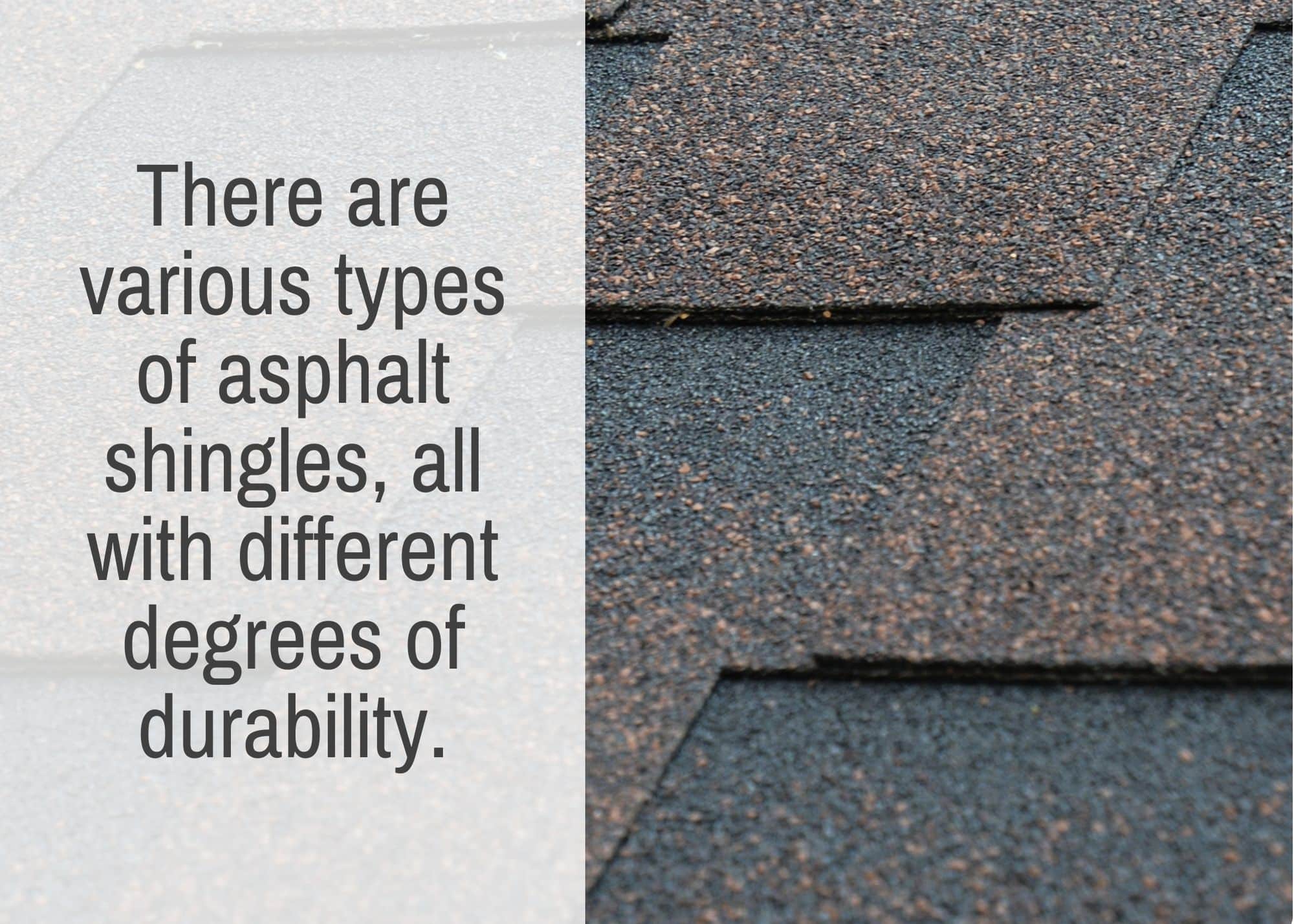
- 3-tab shingles: This is the cheapest and most basic type of asphalt shingle roofing. It’s made with one layer of asphalt and lasts 10-25 years.
- Dimensional shingles: The current most popular type of asphalt shingles, dimensional shingles contain multiple asphalt layers for more durability. They’re slightly more expensive and last 15-30 years.
- Luxury shingles: These shingles are larger and heavier than the other shingle types but also cost more. Luxury shingle roofs should last 30-50 years.
Installing Your Asphalt Shingle Roof
As long as you only have one layer of shingles on your roof, you can theoretically lay another layer on top of them. Any more than two layers and the weight becomes a problem. Many building codes also prohibit a third layer.
However, experts recommend that you always tear off the old shingles first. The shingles will lay nicer over a flat even surface, and you don’t want to worry about the deteriorating shingles underneath causing issues with the new layer on top.
Do It Yourself or Call an Expert?
If you have roofing experience, installing your asphalt shingles yourself is possible. But if you go the DIY route, here are a few things you must keep in mind.
Put your safety first.
Buy or rent a safety harness and use it. Falls and injuries can happen to anyone; if you hurt yourself, your family will suffer far more than they would from having a leaky roof.
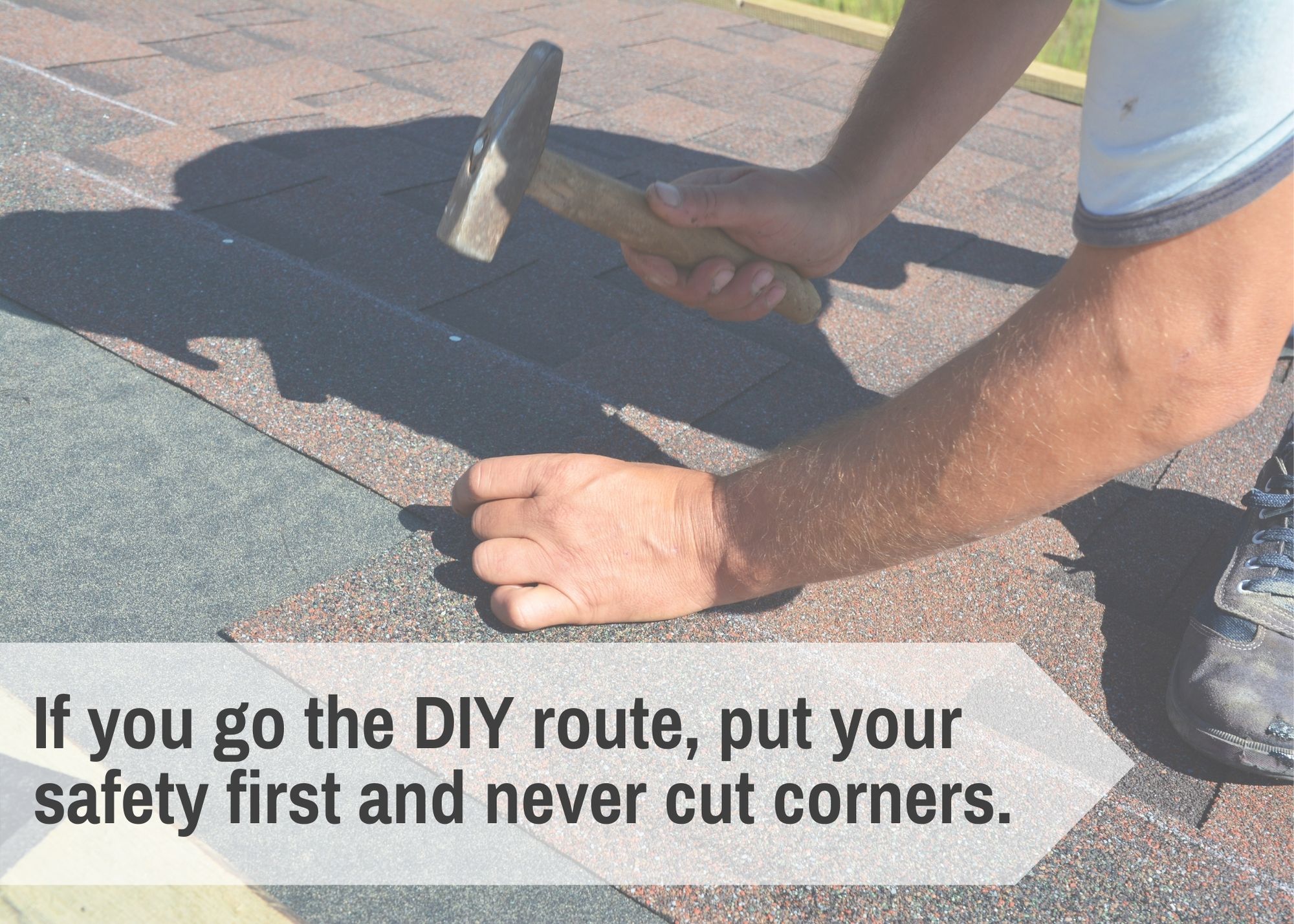
Do the job carefully and correctly.
If you cut corners, it may feel like you’re saving time and money, but in the long run, you’re flushing money down the toilet because the roof will break down prematurely.
Make sure you have the tools you need.
Whether you’re buying them, renting them, or borrowing from a friend, you won’t be able to do the job correctly if you don't have the right tools.
To correctly install an asphalt shingle roof, you should have the following:
- Ladders
- Roofing shoes
- Pry bar and shingle tear-off tools to remove old roofing
- A roofing nail gun
- A roofing hammer or hatchet
- An air compressor for running pneumatic tools
- A roofing blade or utility knife to cut shingles
- Chalk line tools
- Measuring tools
- Caulking gun or cement bucket and trowel
- Reciprocating saw and circular saw to cut roof decking (if necessary)
- A way to haul away old shingles, such as a dumpster or truck.
Calling an expert.
When in doubt, always call in an expert to do the job! And don’t just go with the cheapest contractor you can find—after all, the biggest waste of money is installing new shingles incorrectly. The roofer you choose should be honest and transparent, communicate well, and have good references.
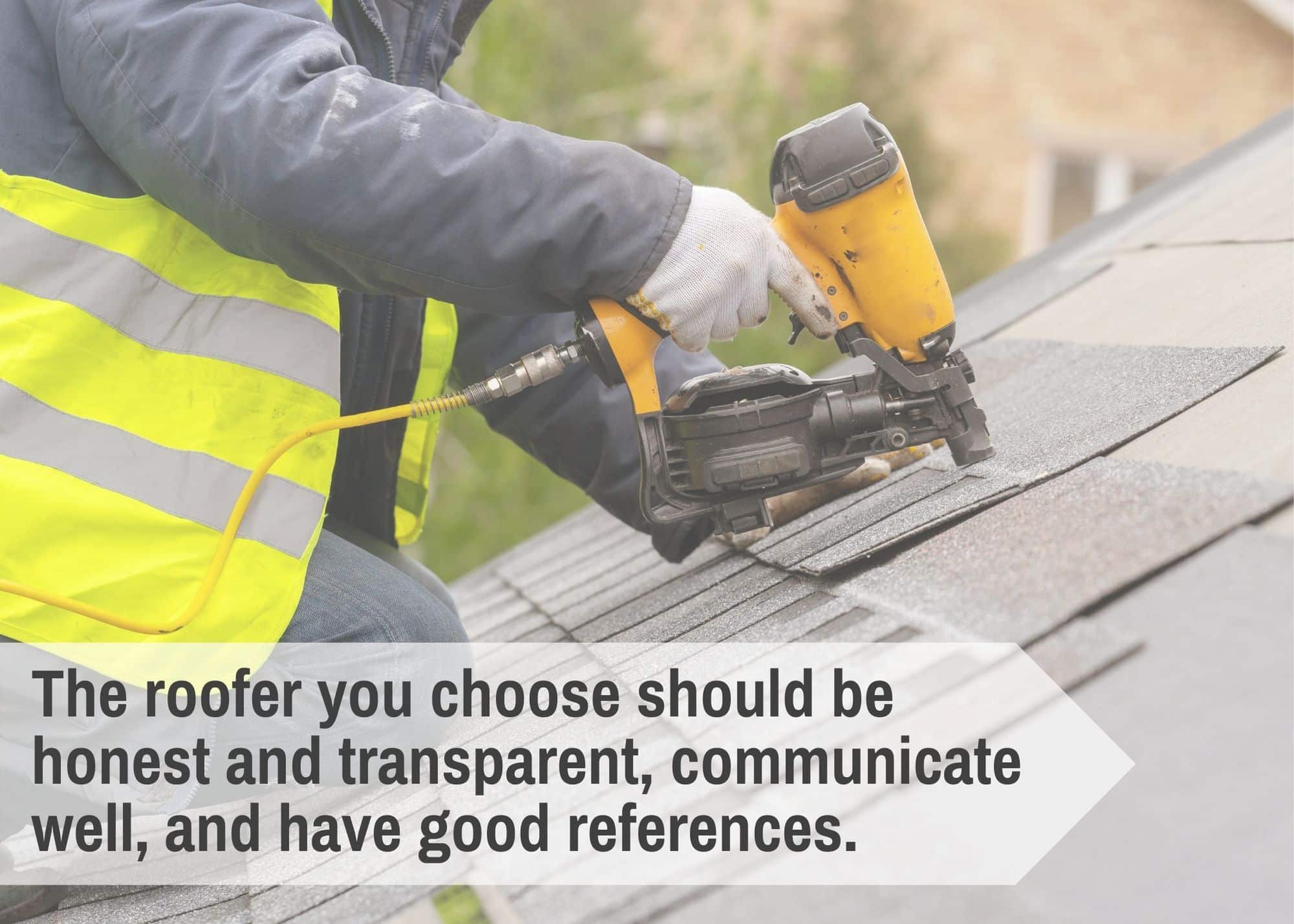
Corrugated Metal Roofing: What You Need to Know
Corrugated metal is sheet metal that’s been pressed into a wavy pattern. Since corrugated metal is mass-produced, cheap, lightweight, and durable, it’s ideal for many building projects, including roofing.
History of Corrugated Metal Roofing
In 1829, Henry Robinson Palmer invented corrugated metal when he discovered that bending a sheet of wrought iron into a wavy shape increased its tensile strength and made it corrosion-resistant.
Corrugated metal proved to be such a useful building material that it soon became popular, particularly with semi-skilled builders in rural areas. It was used for many different purposes, one of which was roofing.
In the 1890s, corrugated metal panels switched from being made of wrought iron to mild steel. Today, corrugated metal is typically made from stainless steel, aluminum, or copper.
Pros and Cons of Corrugated Metal Roofing
Like asphalt shingle roofing, corrugated metal roofing has its pros and cons. Let’s look at them.
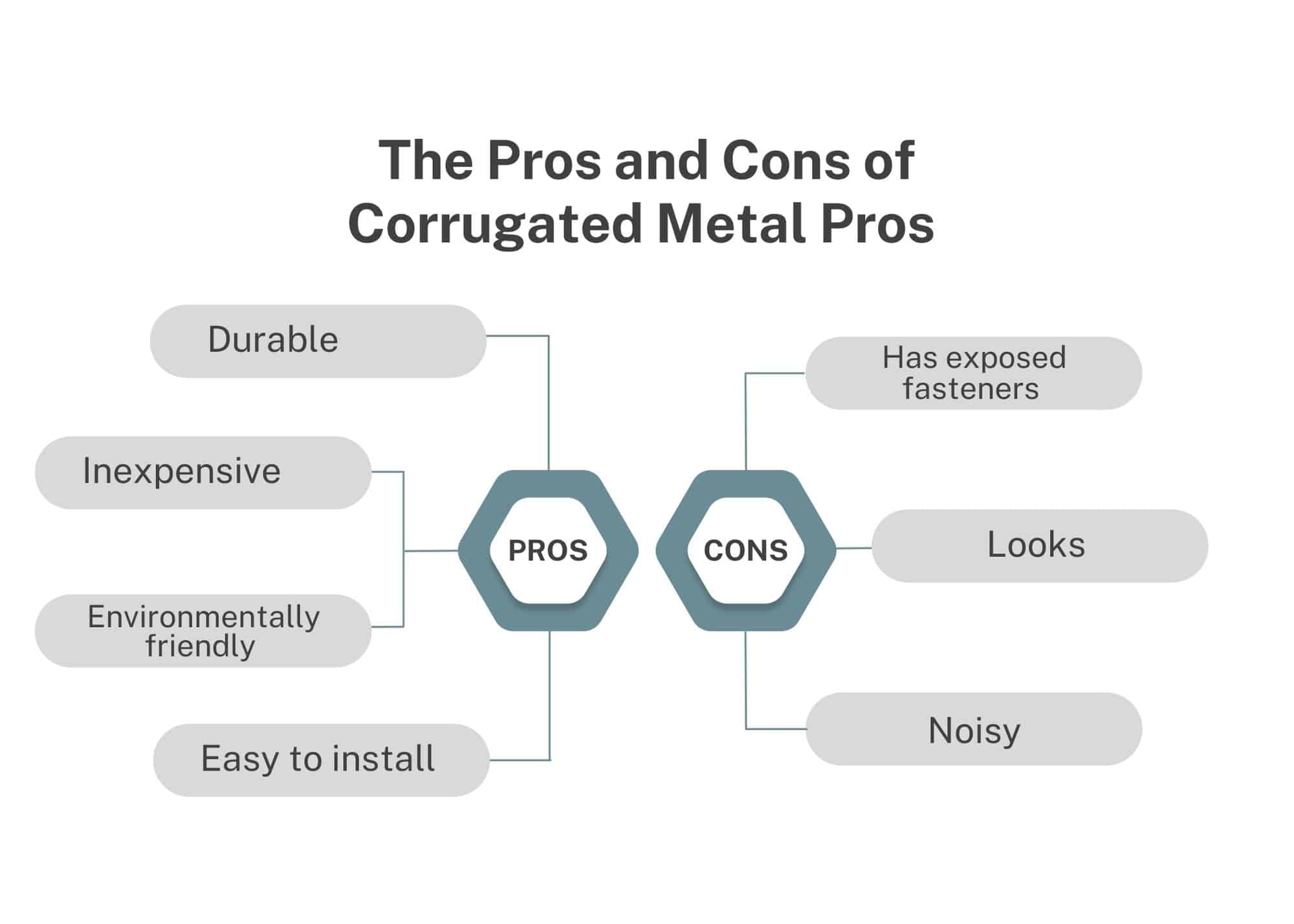
Pros
- Durable: In general, metal roofs can withstand much more than shingle roofs. Your corrugated metal roof should last at least 35-40 years.
- Inexpensive: Corrugated metal costs slightly more than asphalt shingles for both materials and installation, but it’s the cheapest type of metal roofing.
- Environmentally friendly: Corrugated metal can easily be repurposed and recycled.
- Easy to install: Although it should be installed by someone who knows what they’re doing, corrugated metal roofing installation does not require a specialized skill set. It’s also generally faster than installing shingles.
Cons
- Has exposed fasteners: The biggest con to corrugated metal roofing is that the fasteners are exposed to the elements and may begin rusting or leaking over time.
- Looks: Since corrugated metal roofing is popular on industrial and farm buildings, it can make a building look cheap or shed-like.
- Noisy: Rain on a corrugated metal roof is loud, although you can dampen it with an insulated attic.
Types of Corrugated Metal Roofing
When you think of corrugated metal roofing, you might picture the wavy galvanized steel that sheltered your grandpa’s goat shed.
However, you have various options that produce wildly different looks, depending on what you’re after.
Exposed fastener panels
Traditional corrugated metal has an even wavy shape, but you can also buy roofing panels with different patterns, some of which might be a bit more your style. These include:
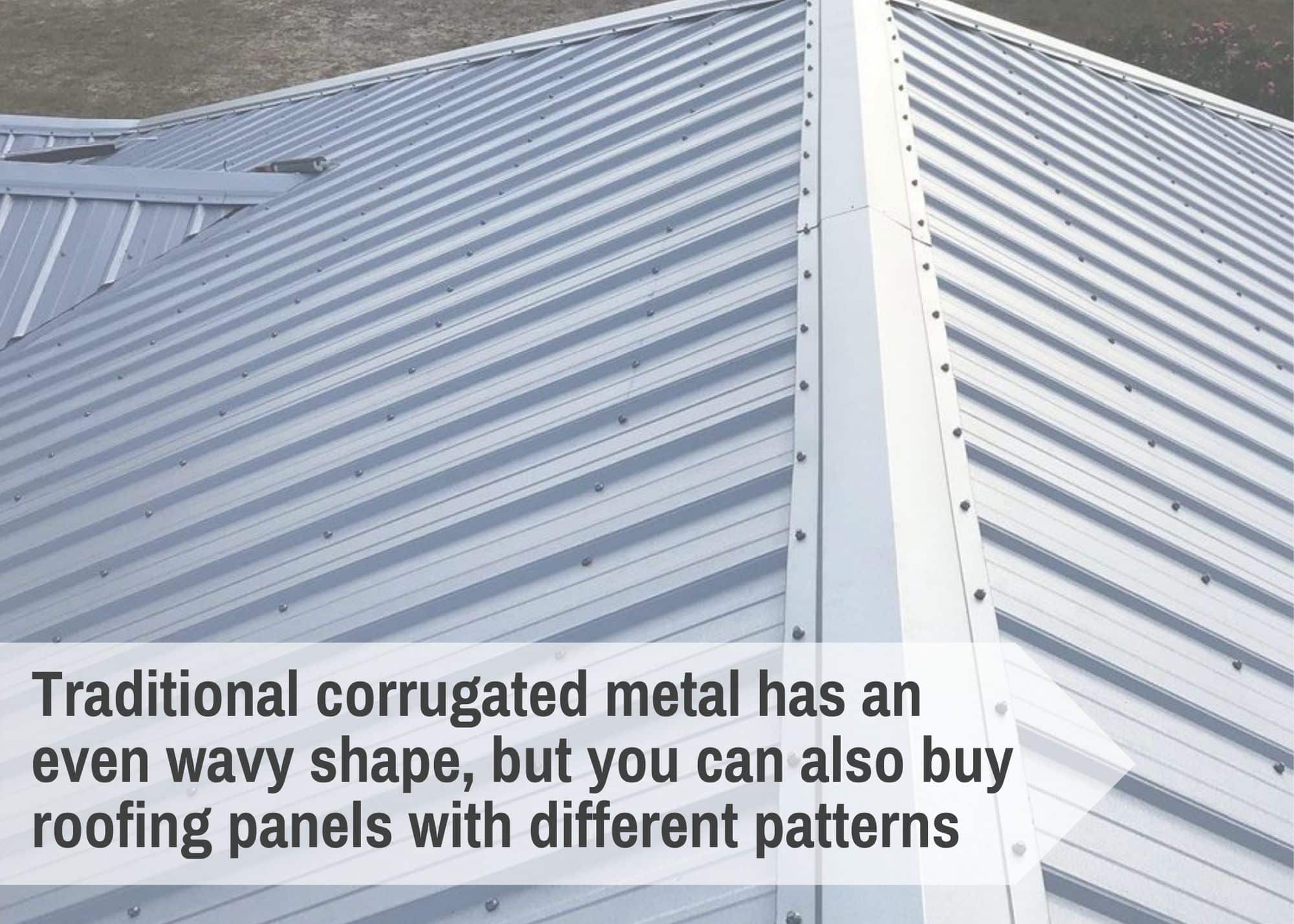
Metal choices
Corrugated roofing panels also come in different metal types, such as:
- Stainless steel
- Corrugated steel
- Aluminum
- Copper
Roofing panels are frequently painted, so you have many color options to choose from as well.
Installing Your Corrugated Metal Roof
It’s pretty standard to install corrugated metal roofing over shingles, but you should check your local building codes to ensure it’s allowed.
Some areas may only allow you to install over one layer of shingles, while in others, you may get by with installing over two or more layers.
Do It Yourself or Call an Expert?
If you have roofing experience, installing your corrugated metal roof yourself is possible. But just like asphalt shingles, go into it carefully and thoroughly prepared.
Put your safety first.
You don’t want to hurt yourself while installing your roof—it would be unkind to the people you love and provide for! Acquire a safety harness and use it. Consider buying a pair of roofing shoes, so you have good traction. Finally, since metal roofing has sharp edges, handle it carefully while wearing a good pair of gloves.
Do the job carefully and correctly.
Pay special attention to the fasteners—this is the weak point of your roof, so make sure to install them snugly and correctly so your roof won’t leak.
Make sure you have the tools you need.
Like with an asphalt shingle roof, don’t start the job until you know you have the right tools!
Besides your safety equipment, you should have the following:
- A Ladder
- Measuring tools
- Fastener drivers to make roof installation much faster and easier
- Angle grinder or circular saw to cut panels
- Nibblers and metal snips for more minor cuts
- Drill with a 4.8 mm drill bit (unless your panels come with pre-drilled holes)
- Hand-held metal bender
Calling an expert.
Remember, if you’re not a handyman or woman, you can always call in a roofer to get the job done! This allows you to relax, knowing that an expert with the correct tools is installing your roof quickly while you get on with everything you’d rather be doing.
Standing Seam Metal Roofing: What You Need to Know
Standing-seam metal roofing consists of metal roofing panels specifically designed with raised “seams” that cover the fasteners.
History of Standing Seam Metal Roofing
Although we have some historical examples of standing-seam metal roofs, such as the copper roof of Christ Church in Philadelphia, built in 1727, the modern standing-seam roof rose to popularity in the 1960s.
Today, standing-seam roofing is mass-produced and easily accessible. It’s popular because the seams cover the fasteners, making the structure more watertight and aesthetically appealing than corrugated metal.
Pros and Cons of Standing Seam Metal Roofing
What are the pros and cons of standing seam metal roofing, and how does it compare to other types of roofing?
Let’s get into it.
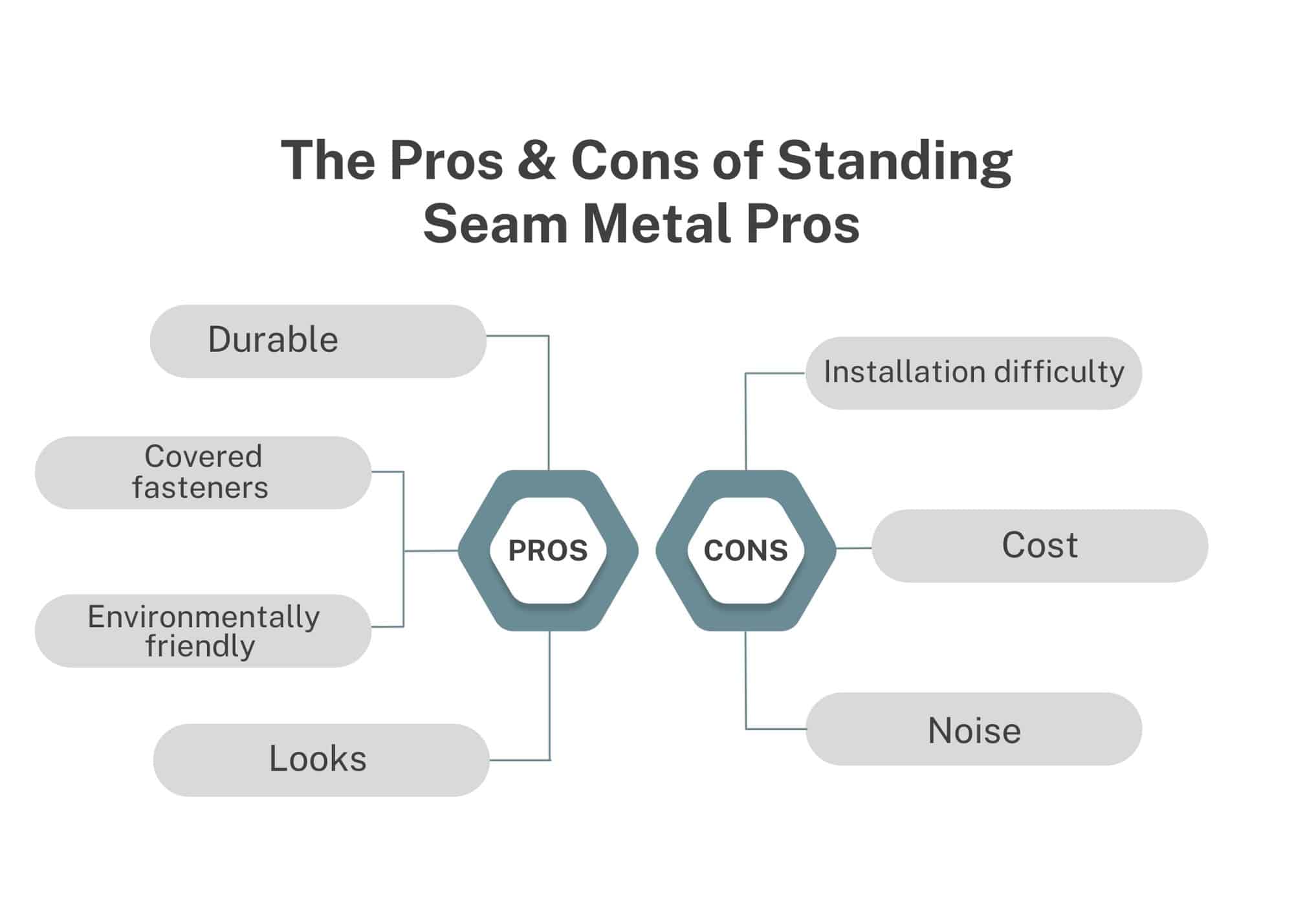
Pros
- Durable: In general, metal roofs can withstand much more than shingle roofs can, and standing-seam metal roofing is no exception. Metal roofing resists fire, rot, and insects.
- Covered fasteners: Unlike corrugated metal roofing and other exposed-fastener roofing options, the seams of standing seam metal roofing cover the fasteners, keeping them from rusting and leaking. Without this weakness, your standing seam metal roof should last at least 30-50 years.
- Environmentally friendly: Standing seam metal roofs can easily be repurposed and recycled.
- Looks: This could be a pro or a con, depending on your taste. Most people prefer the look of standing seam metal roofs to corrugated metal roofs, but if you’re re-roofing your home, you may still prefer the look of shingles.
Cons
- Installation difficulty: Standing-seam metal roofs are difficult to install. They’re not DIY-friendly and should be installed by an expert.
- Cost: Standing-seam metal roofs cost more than other roofing types for both the product and the installation.
- Noise: Rain on any type of metal roof will be louder than a shingle roof, though if this bothers you, you can dampen the noise with an insulated attic.
Types of Standing-Seam Metal Roofing
Like all roofing types, standing-seam metal roofing has various subtypes that vary in looks, durability, and difficulty of installation.
Locking systems
Standing seam metal roofing panels lock together, but there are several types of locking systems to choose from:
- Snap-lock: Panels that snap together rather than being folded together with a machine during installation.
- Mechanical seam: Panels with legs that must be folded together with a machine during the installation process.
- Batten-panel: Panels where a cap is snapped or seamed onto the panel legs to join them together.
Sizes, colors, and patterns
You can vary the look of your roof by choosing different sizes, colors, and patterns.
For instance, you can choose panels with more or less space between the seams, and with taller or shorter seams, depending on your preferred look.
Although many standing seam roofing panels are flat between the seams, you can buy panels with extra ridges between the seams. This gives your panels a unique look and also helps prevent oil canning.
Installing Your Standing Seam Metal Roof
Like corrugated metal roofing, it’s common to install standing seam roofing over shingles. Still, you should check your local codes to make sure it’s allowed. Sometimes you won’t be allowed to install over two or more layers of shingles, but installing over one layer of shingles is legal in most places.
Do It Yourself or Call an Expert?
Unlike shingles or corrugated metal roofing, standing seam metal roofing requires a level of expertise that most people, even if they have roofing experience, don’t possess.
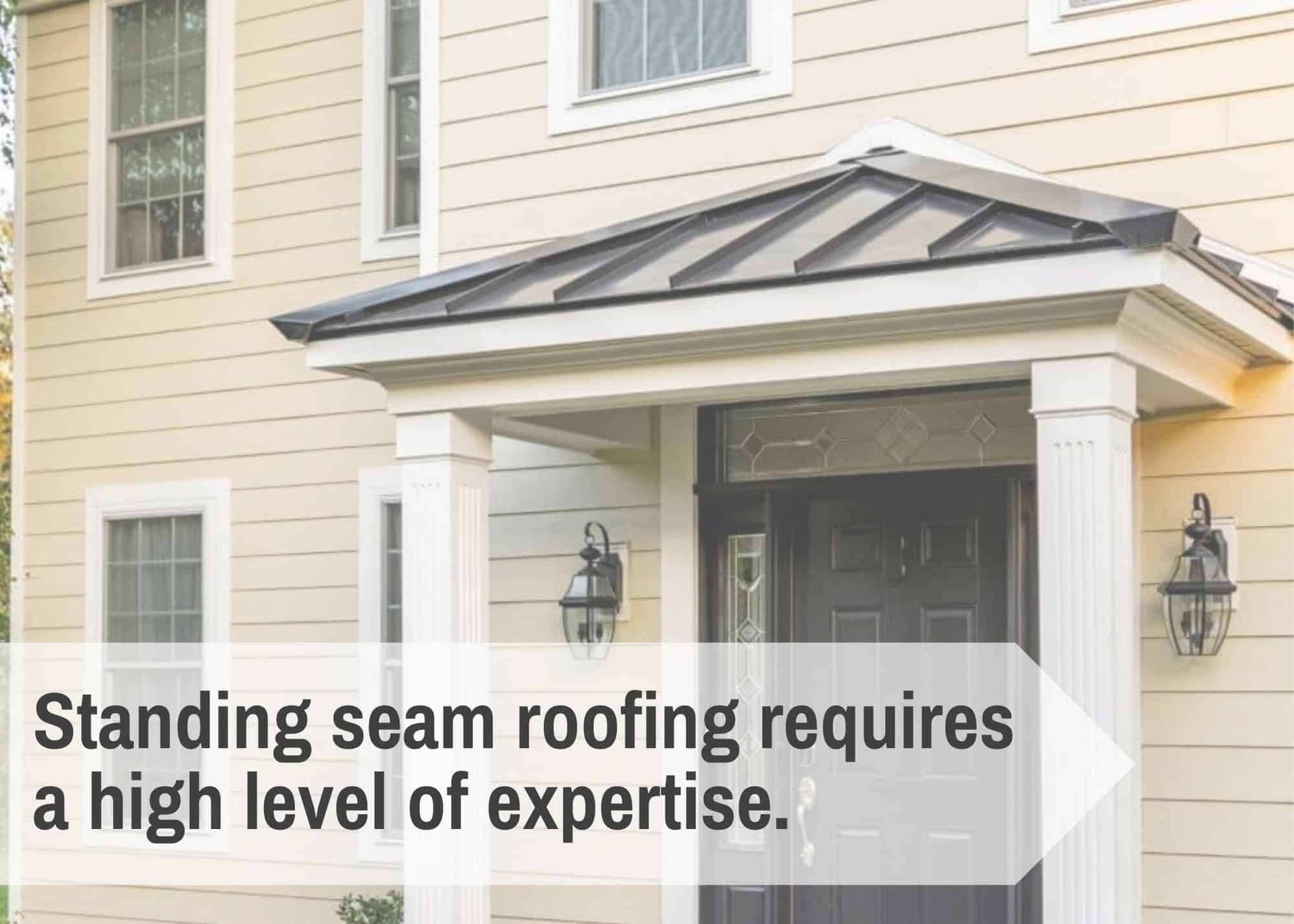
We highly recommend you call in an expert to install your standing seam metal roof.
Some things on your property are safer to DIY than other things. For instance, if you try to build your own patio and it goes badly, you’ve wasted some time, but that’s about the extent of your woes.
But if you try to do your own roofing and it goes badly, the resulting leaks can cause structural damage, costing an arm and a leg in repairs.
If you have experience installing standing seam metal roofing and want to give it a go, thoroughly research how to install the type of locking system you choose.
Also, please acquire the proper tools, and don’t forget the safety harness!
Where Can I Find a Roofing Expert?
Sometimes it can take time to find the right professional to do the job. Make sure to choose a roofing company that is helpful, transparent, and has good communication skills and good reviews.
If you live in Pennsylvania, New Jersey, or Delaware, give Choice Exteriors a call! We’d love to chat with you about your roofing options.
Besides roofing services, we also offer:
- Stucco Remediation
- Siding Services
- Window and Door Installation
- Exterior Trim Installation
- Decking Services
Call us today, or use our online tool to schedule an estimate. We can’t wait to hear from you!




